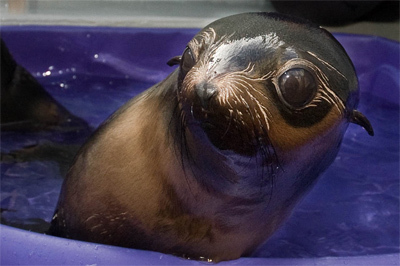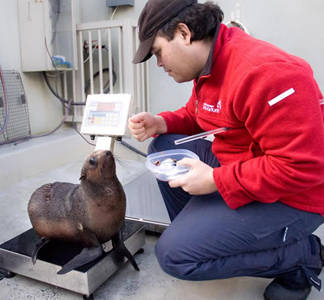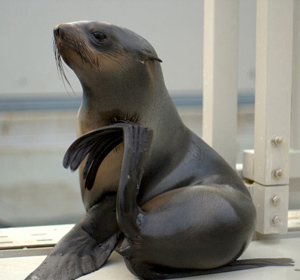
A recent experience with young northern fur seals resulted in unexpected insights into the physiology of fur seals, and stronger synergy between researchers and marine mammal trainers. The results represent a breakthrough in the world of conservation and animal care.
The experience began when a 5-member team from the University of British Columbia and the Vancouver Aquarium brought 6 female northern fur seals from St. Paul Island in the Bering Sea to Vancouver. The fur seals had just weaned and were about to depart on their 2-year journey at sea.
“This is a critically important time for young fur seals,” remarked Dr. Andrew Trites, Research Director of the Marine Mammal Research Consortium and one of the team members that went to St. Paul to capture the animals. “In many species of mammals, the transition from milk to solid food is a major hurdle that determines whether they will survive to become breeding members of the population. Unfortunately, since fur seals disappear at sea for two years, it is that part of their lives that scientists know the least about. That is why we wanted to bring young fur seals to Vancouver — to figure out whether these early formative years are connected to the population declines we have seen in the wild”.
 The fur seals began providing data as soon as they arrived at the Marine Mammal Energetics and Nutrition Laboratory at the Vancouver Aquarium. They quickly adapted to their new settings under the guidance and professional training and veterinary staff. However, the research and care team quickly realized something was very different about these young fur seals compared to the Steller sea lions and harbor seals they were used to working with.
The fur seals began providing data as soon as they arrived at the Marine Mammal Energetics and Nutrition Laboratory at the Vancouver Aquarium. They quickly adapted to their new settings under the guidance and professional training and veterinary staff. However, the research and care team quickly realized something was very different about these young fur seals compared to the Steller sea lions and harbor seals they were used to working with.
“We very quickly got the fur seals eating fish, and they seemed very relaxed in their new environment,” said Billy Lasby, head pinniped trainer. “However, after several weeks, we noticed that they really were not gaining much weight. Weight gain is something we expect and use as a measure of health, but these little guys just were not putting on much weight, despite every other aspect of their behavior and medical tests indicating they were doing well. Some of them actually started to lose weight as the winter progressed. We tried all sorts of things to increase their food intake and body mass — but with no success. Often they just threw it up if we gave them more to eat.”

“It became a bit of an issue,” remembers Dr. David Rosen. “Here we are trying to conduct all of this research, including changes in food availability, and at the same time the vet staff wants us to feed, feed, feed. And the training staff is feeling stuck in the middle. We managed to complete all of our studies, and found the animals started to gain weight again by spring”.
It was only after Dr. Rosen began analyzing the data and thinking about the natural ecology of northern fur seals that things became clearer. “Our winter data showed that we were dealing with a creature that was physiologically tuned to just trying to survive winter in the North Pacific Ocean. They had extremely low metabolism, and were very efficient at converting food into energy — but their physiology was not really set up to process a lot of food and turn it into growth.” This would explain why the training staff had such difficulty getting the fur seals to eat lots and put on weight – they simply are not set up to do that.”
During spring and summer, the physiology of the animals underwent a dramatic change. “Metabolism increased, food intake surged, and the fur seals seemed driven to convert food into mass as quickly as possible. This is what we were expecting to see from young seals and sea lions.” However, the fur seals also lost dramatic amounts of body mass when they did not get enough to eat.
Dr. Rosen feels that the trainers and scientists were dealing with two very different creatures, physiologically, and that this dualism makes perfect sense when viewed in terms of the natural ecology of fur seals living in the North Pacific. “We think that during the winter we were dealing with an animal that was more attuned to making the most of sparse resources and riding out any short periods of poor food availability. They are really keyed to just survive these initial harsh months. Then during the spring and summer, the fur seals may ramp up their physiology to take advantage of more predictable and plentiful food resources in the North Pacific, resulting in higher growth that ultimately affects their ability to survive and reproduce. The downside is that the consequences can be quite severe if they cannot find prey because they have such a huge metabolic engine to keep fuelled.”
For both the trainers and researchers, the results of the studies provide novel insights. “In their second winter with us”, remarks Billy Lasby, “they again cut back
their food intake and lost weight. However, now we knew it was part of their normal life history and could deal with it more easily from a husbandry and research perspective.”
